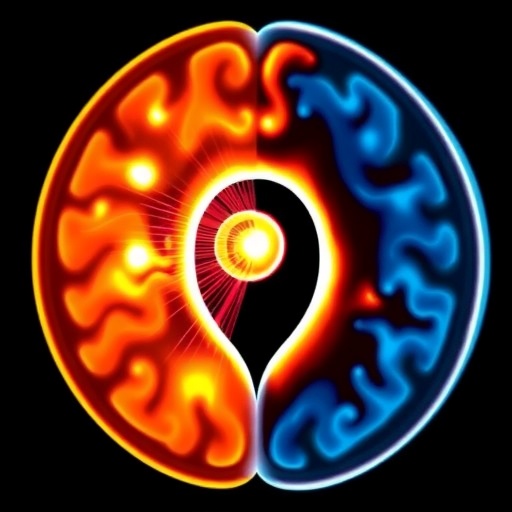A Revolutionary AI-Driven Breakthrough in Contrast-Free MRI Imaging for Tumor Detection
Magnetic resonance imaging (MRI) is a cornerstone in medical diagnostics, yet its reliance on contrast agents such as gadolinium presents significant health risks. Gadolinium-based contrast agents (GBCAs), though highly effective at enhancing image clarity, have long been associated with adverse effects ranging from nephrogenic systemic fibrosis to concerns about long-term brain accumulation. Addressing these challenges, researchers at The Hong Kong Polytechnic University (PolyU) have pioneered an innovative AI-powered approach to MRI imaging that eliminates the need for these potentially harmful substances while maintaining, and even enhancing, image accuracy for tumor detection.
Nasopharyngeal carcinoma (NPC), a malignancy originating in the complex anatomical region of the nasopharynx, is particularly prevalent in Southern China, presenting a daunting challenge to clinicians due to its proximity to critical structures like the skull base and cranial nerves. High-fidelity imaging plays an indispensable role in managing NPC, especially in guiding radiation therapy, the primary mode of treatment. Traditional contrast-enhanced MRI using gadolinium has been the gold standard, but its associated risks have driven an urgent need for safer imaging alternatives without compromising diagnostic precision.
.adsslot_zAh6Y02Gro{width:728px !important;height:90px !important;}
@media(max-width:1199px){ .adsslot_zAh6Y02Gro{width:468px !important;height:60px !important;}
}
@media(max-width:767px){ .adsslot_zAh6Y02Gro{width:320px !important;height:50px !important;}
}
ADVERTISEMENT
Professor Jing Cai, Head of the Department of Health Technology and Informatics at PolyU, has dedicated extensive research efforts to overcoming these challenges by leveraging deep learning and neural networks. In 2022, his team introduced the Multimodality-Guided Synergistic Neural Network (MMgSN-Net), an advanced AI system designed to synthesize virtual contrast-enhanced images from contrast-free MRI scans. This innovative network integrates information from both T1-weighted and T2-weighted images, extracting complementary features that help produce synthetic images that mimic the clarity once reliant on gadolinium contrast.
The architecture of MMgSN-Net is sophisticated and multi-faceted. It includes a multimodality learning module that disentangles tumor-related features unique to each MRI modality, a synergistic guidance system that fuses the modalities to enhance feature representation, and a self-attention mechanism that preserves the structural integrity of surrounding anatomical features. Together, these components enable MMgSN-Net to achieve high-quality virtual contrast enhancement, overcoming the limitations faced by approaches based on a single imaging modality.
Building upon this foundation, in 2024, Prof. Cai and his collaborators further advanced virtual contrast enhancement by integrating Generative Adversarial Network (GAN) technology with pixelwise gradient methods, resulting in the Pixelwise Gradient Model with Generative Adversarial Network for Virtual Contrast Enhancement (PGMGVCE). This model is designed not only to synthesize contrast-like enhancements but to faithfully replicate the intricate textures and structures that characterize real contrast-enhanced MRI images, thereby pushing the boundaries of medical image synthesis.
GANs consist of two competing neural networks: a generator responsible for creating synthetic images and a discriminator that evaluates the authenticity of these images. Their dynamic interplay enhances the generator’s ability to produce highly realistic images over time. In the PGMGVCE model, the pixelwise gradient method is a crucial addition, adept at capturing detailed geometric structures from tissue, ensuring the spatial accuracy of generated images. This coupling enables PGMGVCE to produce images that are nearly indistinguishable from traditional gadolinium-enhanced scans.
Quantitative assessments reveal that while PGMGVCE and its predecessor MMgSN-Net are comparable in accuracy metrics such as mean absolute error (MAE), mean square error (MSE), and structural similarity index measure (SSIM), PGMGVCE distinctly outperforms MMgSN-Net in replicating realistic texture. Texture fidelity is vital for clinical utility, as subtle details and boundaries within tumor regions guide crucial diagnostic and therapeutic decisions. Advanced texture metrics like total mean square variation per mean intensity (TMSVPMI) and Tenengrad function per mean intensity (TFPMI) confirm PGMGVCE’s superior representation of nuanced textures.
Fine-tuning the model involved a rigorous exploration of hyperparameters and normalization techniques. The optimal balance between pixelwise gradient loss and GAN loss was found at an equal 1:1 ratio, ensuring that shape and texture features were both effectively captured. Different normalization methods—z-score, Sigmoid, and Tanh—were tested, with Sigmoid normalization emerging as the best performer, marginally improving the MAE and MSE metrics. These findings underscore the importance of thoughtful architecture optimization in deep learning for medical imaging.
An important insight from this research is the benefit of multimodal input. The PGMGVCE model exhibited significantly enhanced performance when integrating both T1-weighted and T2-weighted images compared to relying on a single modality alone. This synergy broadens the anatomical and pathological information accessible to the network, improving virtual contrast enhancement and refining tumor boundary definition. Such multimodal fusion represents a promising avenue to further improve non-invasive tumor imaging.
Looking ahead, ongoing research aims to expand training datasets and incorporate additional MRI modalities to bolster the robustness and generalizability of these models across diverse patient populations and imaging platforms. Integrating functional imaging data, such as diffusion-weighted imaging or perfusion sequences, could further enrich model capabilities. As these technologies continue to evolve, they herald a paradigm shift toward safer, smarter, and more accessible imaging diagnostics that could revolutionize cancer management worldwide.
Ultimately, the fusion of AI and medical imaging exemplified by the MMgSN-Net and PGMGVCE models marks a transformative leap in MRI technology. It underscores how advanced computational methods can circumvent longstanding clinical challenges, improving patient safety and diagnostic precision. The success from the Hong Kong Polytechnic University team not only advances NPC care but also sets a precedent for future innovation in radiology and precision medicine.
Subject of Research:
Advanced AI-powered virtual contrast enhancement in MRI for nasopharyngeal carcinoma detection
Article Title:
Virtual Contrast-Enhanced Magnetic Resonance Images Synthesis for Patients With Nasopharyngeal Carcinoma Using Multimodality-Guided Synergistic Neural Network
News Publication Date:
15-Mar-2022
Web References:
10.1016/j.ijrobp.2021.11.007
Image Credits:
© 2025 Research and Innovation Office, The Hong Kong Polytechnic University. All Rights Reserved.
Keywords:
Cancer, Head and neck cancer, Magnetic resonance imaging, Gadolinium, Radiation therapy, Tumor tissue
Tags: advanced imaging techniques in oncologyAI-driven MRI imagingcontrast-free tumor detectionenhancing MRI accuracygadolinium-based contrast agents riskshealth risks of gadolinium in MRIinnovative medical imaging technologynasopharyngeal carcinoma imagingnon-invasive tumor diagnosticsPolyU research breakthroughradiation therapy guidancesafer alternatives to traditional MRI





